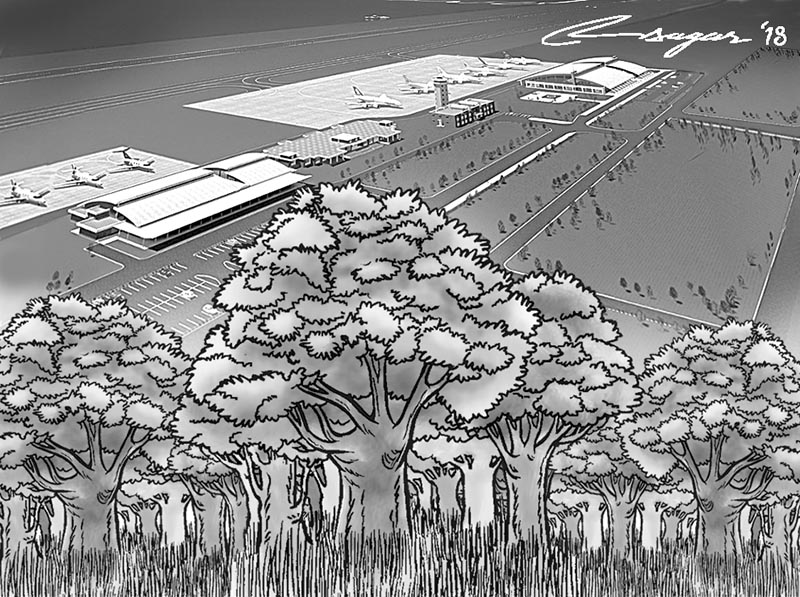New airport in Nijgadh: We must weigh all options
The proposed Second International Airport in Nijgadh of Bara has drawn attention of people from various quarters, and the opinion is divided. Before plunging into such a massive project, it would be better to weigh all the options
Media reports in the recent past suggest Nepal may lose millions of dollars as benefits from carbon trading from nearly 800,000 Sal (Shorea robusta) trees that have to be axed for creating space for the Second International Airport (SIA) in Nijgadh. Reports also suggest that around 2.4 million trees in total have to be cut. The government has claimed that the SIA will be the biggest airport in South Asia. The cost of the airport has been estimated to be $1.6 billion.
The first question that comes to the mind is: Do we really need such a gargantuan airport? If the risk analysis based on key factors like environment, economics and social and bio-diversity says the SIA is a must, then we should go for it.
But I believe so far people do not have the knowledge of the DPR (detailed project report). As an agricultural and irrigation engineer who has also spent quite some time writing on economics and environment issues, I believe this mega project can prove to be an environmental, economic and social/ethnic disaster — something which can never be compensated back.
Technically, the proposed SIA is a massive project and is four times bigger than Atlanta International Airport in the US. And since an aero city too has been proposed near the SIA, it will cover a huge area of 8,000 hectares in the midst of thick rain forests (Char Kose Jhadi).
And who can guarantee remaining Sal forests around it will remain as such for future generations. It is for sure there is sheer lack of farsightedness in the planning of this mega airport. Economically the tentative cost estimate is proposed around $1.6 billion and the government claims it can recover half of the cost by selling the felled trees.
I believe the best location would have been the southern part of Chitwan which was earlier planned — but dropped — for reason that the jets’ sound would affect the wildlife in the Chitwan National Park. If so how about Africa where thousands of international flights crisscross the whole continent every day? This option was missed by Nepal nearly three decades ago.
There is no sense in building the SIA which will be four times bigger than Atlanta International Airport (so far one of the biggest in the world) which has capacity to handle 110 million passengers. It will take a long time — may be a century— for Nepal to have even one-sixth capacity arrival of Atlanta.
Building the airport in the midst of dense rain forests will result in loss of precious biological corridor with immediate loss of 90 species of precious and endangered flora and fauna. And immediate resettlement of nearly 1,500 native population of Tangria Basti will be another challenge. Not to mention the loss of habitats of rare Asiatic elephants and tigers. We will lose hard earned reputation as a leader nation in nature conservation.
What are the options then?
No doubt the only international airport in the country — Tribhuvan International Airport (TIA) — is congested. But to ease air traffic at the TIA, can we afford to build another airport which has huge economic and environmental cost?
The first thing the government should do is expanding the TIA to the extent possible. TIA still has three more hours to accommodate flights, as it is currently operating for 21 hours a day. Then, there is Simara Airport which can be upgraded. Since two international airports — in Pokhara and Bhairahawa — are being built, these could suffice the need of Nepal. By spending the money that we would be putting to build the SIA in Nijgadh, we can have at least three world class international airports with aero cities.
The real investment must be augmented in the agriculture sector which still provides one third of the GDP. Nepal still has a lot of potential in the tourism sector. But it is yet to contribute more than 3 per cent to the GDP. The one sector that can bail the country out of economic problems is but agriculture.
Our import export ratio of 15 to 1 can be improved only with needed investment in agriculture which is still the most neglected sector.
The tourism sector needs heavy investment, but this must be made carefully to match with only the practical arrival demands of future till 2050. So, for now investment in upgradation of the TIA and Simara Airport and adding capacity in Lumbini and Pokhara international airports is the most viable solution, which will have minimum environmental and social impacts.
Yes, of late the debate has been raging over the SIA in Nijgadh and there are clearly two divided opinions — one saying a second international airport is a must and that development is not possible without losing some biodiversity and the other making a pitch for saving the environment. Those who fall in the second category are easily branded “anti-development” and I too run the risk of being called one who opposes development.
Development certainly comes at a cost; the only argument I am trying to make is we should weigh the cost — and if the environmental, economic and social cost is too high compared to the development output, how wise a decision it would be if we go for building a massive airport. It’s better to be safe than sorry.
Rana, an economist and agriculture/irrigation engineer, writes on environment issues






